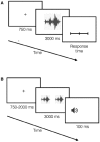Negative emotion provides cues for orienting auditory spatial attention
- PMID: 26029149
- PMCID: PMC4428076
- DOI: 10.3389/fpsyg.2015.00618
Negative emotion provides cues for orienting auditory spatial attention
Abstract
The auditory stimuli provide information about the objects and events around us. They can also carry biologically significant emotional information (such as unseen dangers and conspecific vocalizations), which provides cues for allocation of attention and mental resources. Here, we investigated whether task-irrelevant auditory emotional information can provide cues for orientation of auditory spatial attention. We employed a covert spatial orienting task: the dot-probe task. In each trial, two task-irrelevant auditory cues were simultaneously presented at two separate locations (left-right or front-back). Environmental sounds were selected to form emotional vs. neutral, emotional vs. emotional, and neutral vs. neutral cue pairs. The participants' task was to detect the location of an acoustic target that was presented immediately after the task-irrelevant auditory cues. The target was presented at the same location as one of the auditory cues. The results indicated that participants were significantly faster to locate the target when it replaced the negative cue compared to when it replaced the neutral cue. The positive cues did not produce a clear attentional bias. Further, same valence pairs (emotional-emotional or neutral-neutral) did not modulate reaction times due to a lack of spatial attention capture by one cue in the pair. Taken together, the results indicate that negative affect can provide cues for the orientation of spatial attention in the auditory domain.
Keywords: auditory perception; auditory spatial attention; covert spatial orienting; dot-probe task; emotion.
Figures


References
LinkOut - more resources
Full Text Sources
Other Literature Sources

